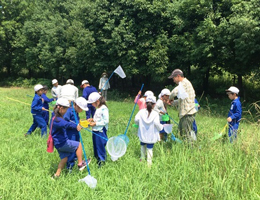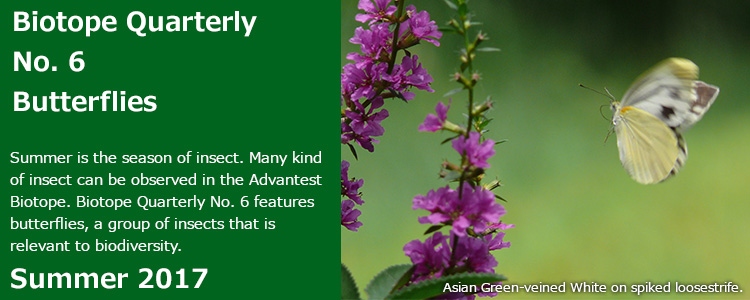
Butterflies are a barometer for biodiversity
Larvae of many butterfly species feed only on specific plants (called "oligophagous").
When female butterflies lay their eggs, they choose a site by identifying the plants that
their larvae can feed on. This means a biotope that is visited by many species of butterflies is a biotope home for many species of plants. It is true that there are species of
butterflies whose larvae feed on many kinds of plants (called "euryphagous"), but these species tend to be pest insects or those designated as "invasive alien species."
The adult butterflies like to feed on flower nectar and tree sap. Although the naturally growing trees in our biotope are sappy species, such as sawtooth oak and konara oak, the volume of the sap tends to decrease as the trees age. The number of butterflies in the biotope seems to be decreasing slightly (we cannot say for sure because no quantitative observation has been carried out), and we suspect it is caused by the decreasing volume of tree sap.
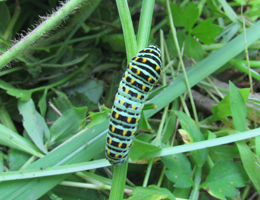
Butterflies visiting the Advantest Biotope (in alphabetical order)
- Asian swallowtail
-
Family: Papilionidae; Scientific name: Papilio Xuthus
Larval host plants: plants in orange and Japanese pepper groups
Along with the old world swallowtail, the Asian swallowtail is the most commonly seen swallowtail in Japan. Although the two species look very similar, the Asian swallowtail has streaky patterns on the front part of the front wings. The larvae of the two species feed on different plants: the old world swallowtail feeds on parsley and carrot leaves, while the Asian swallowtail feeds on leaves of oranges and Japanese pepper.
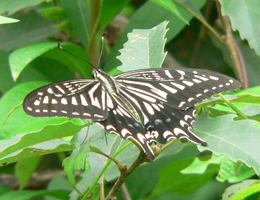
- Common bluebottle
-
Family: Papilionidae; Scientific name: Graphium sarpedon
Larval host trees: trees in the Lauraceae (laurel) family
Camphor, the host tree of the common bluebottle, is native to southern areas. As camphor is non-deciduous and does not attract many pests, it is relatively easy to take care of. For this reason, camphor trees have commonly been planted as roadside trees, and the common bluebottle butterfly has been expanding its habitat to more northern areas. Advantest, too, planted camphor trees along the business premises where the biotope is located at the time of its opening.
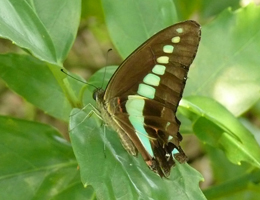
- Common grass yellow
-
Family: Pieridae; Scientific name: Eurema mandarina.
Larval host plants: species in Fabaceae (pea) family (Sericea lespedeza, etc.)
Common grass yellow (Eurema hecabe) was classified into two different species in 2005: a species living in the Honshu Islands and Nansei Islands of Japan (Eurema mandarina) and a species living in Nansei Islands, as well as other parts of Asia and Oceania (Eurema heveca). Although the two species are different in the ultraviolet reflection on the wing surface and results of DNA analysis, it is impossible to differentiate them visually.
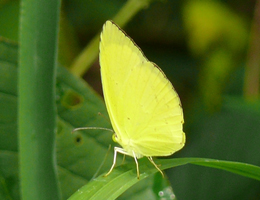
- Eastern pale clouded yellow
-
Family: Pieridae; Scientific name: Colias erate
Larval host plants: species in the Fabaceae (pea) family (white clover, tufted vetch, etc.)
As we limit human intervention to as little as possible at the biotope, the plants in the pea family, which grow vigorously if left, will naturally make an environment favored by Eastern pale clouded yellow butterflies. The colors of their wings are usually bright yellow for males and pale yellow for females (shown in the photo), but female butterflies with bright yellow wings are found on rare occasions.
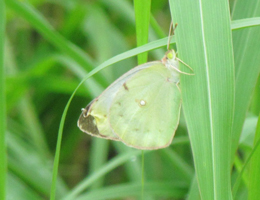
- Freyer's purple emperor
-
Family: Nymphalidae; Scientific name: Apatura metis
Larval host trees: trees in the Salicaceae (willow) family
Male freyer's purple emperor displays beautiful purple colors on its wings depending on the angle of light. In this biotope, they were identified frequently until several years ago, but the number has been decreasing recently possibly due to the reduction of tree sap.
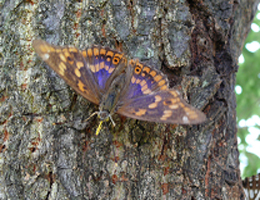
- Indian fritillary
-
Family: Nymphalidae; Scientific name: Argyreus hyperbius
Larval host plants: plants in the Violaceae (violet) family
The wing patterns differ greatly between male and female. The female's wing pattern mimics a poisonous species of butterfly (plain tiger) so that birds avoid feeding on them. Interestingly, the northern limit of plain tiger butterfly distribution is the Nansei Islands, and therefore the effect of mimicking by Indian fritillary in the main island of Japan (they occur in the western part up to the Kanto area) is unknown.
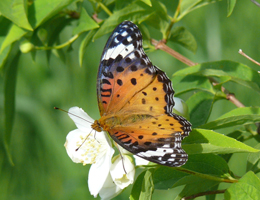
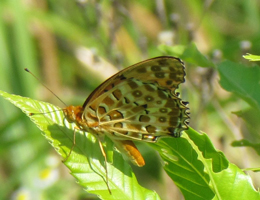
- Japanese oakblue
-
Family: Lycaenidae; Scientific name: Narathura japonica
Larval host trees: trees in the Fagaceae (beech) family (ring-cupped oak, konara oak, etc.)
The Japanese oakblue hibernates over the winter in its adult form. Although there are a lot of places suitable for hibernation (piles of dead leaves, for example) in the Advantest Biotope, we haven't found them in the winter. The two sides of the wings have distinctively different patterns.
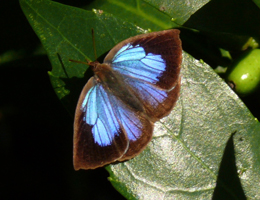
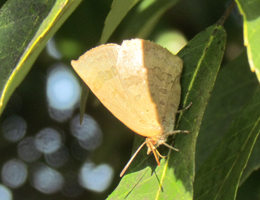
- Red ring skirt
-
Family: Nymphalidae; Scientific name: Hestina assimilis
Near threatened species (subspecies in Amami. Red List of the Ministry of the Environment, Japan)
Caution-needed alien species (Invasive Alien Species Act except Amami subspecies)
Larval host trees: trees in the Ulmaceae (elm) family (Chinese hackberry, etc.)
A subspecies of red ring skirt butterfly is endemic to Japan and found only in the Amami Islands, and it is designated as a near threatened species on the Red List of Japan's Ministry of the Environment. Another subspecies of red ring skirt has been found widely in the Kanto area, including our biotope, for the last 20 years. Sharing common features with the one native to China, this species is most likely to have been introduced to Japan by humans. As the distribution is expanding, concern regarding competition with the siren butterfly and other native species is growing.
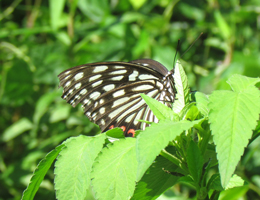
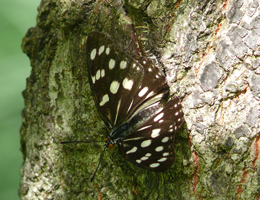
- Scarce tortoiseshell
-
Family: Nymphalidae; Scientific name: Nymphalis xanthomelas
Larvae host trees: trees in the Ulmaceae (elm) family and Salicaceae (willow) family
While most butterflies are seen for a rather long time from the spring to fall, the scarce tortoiseshell appears only in a very limited period (June and July) and goes dormant in the summer. Given that the Advantest Biotope is located near the city of Tatebayashi in Gunma Prefecture, which is known for its extremely hot summers, the butterflies may have a difficult time "sleeping" in the heat.
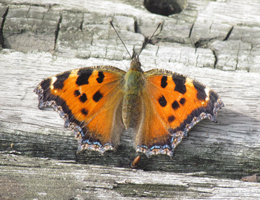
- Silver-lined skipper
-
Family: Hesperiidae; Scientific name: Leptalina unicolor
Near threatened species (Red List of the Ministry of the Environment, Japan)
Larval host plants: plants in the Poaceae (grass) family (silver grass, etc.)
The common name is derived from the straight silver line running through the middle of each wing. While individuals found in spring have strikingly silver lines, the wings of those found in summer are almost all yellow with obscure lines. The silver-lined skipper is designated as a near threatened species in the Red List of Japan's Ministry of the Environment and has not been seen in the Advantest biotope for the last 4 to 5 years.
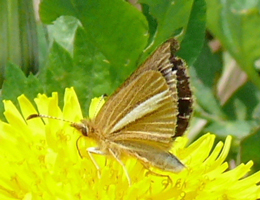
- Small copper
-
Family: Lycaenidae; Scientific name: Lycaena phlaeas
Larval host plants: plants in the Polygonaceae (Buckwheat) family (common sorrel, sheep's sorrel, etc.)
This butterfly was once on 30-yen stamps in Japan. Small coppers commonly appear in the open spaces of this biotope, such as grassy areas. They fly near the ground and perch on plants very often without flying a long distance.
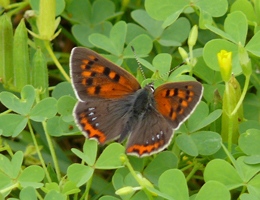
- Small white
-
Family: Pieridae; Scientific name: Pieris rapae
Larval host plants: plants in the Brassicaceae (cabbage) family
Advantest composts the kitchen waste from the company cafeteria and uses it to grow vegetables in a space next to the biotope. The vegetables grown in the garden are used in the kitchen and sold to the employees. The cabbage and daikon radish we grow in the garden, popular produce for our employees, are also favored by the larvae of small white butterfly. This gives us mixed feelings as we have to manage the biotope. Nonetheless, this is also an indication showing that the biotope is a successful environment for nature.
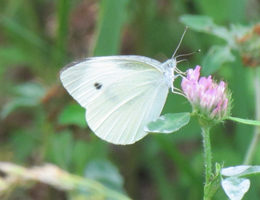
Other butterflies found in the Advantest Biotope
- Asian comma
-
Family: Nymphalidae; Scientific name: Polygonia c-aureum
Larval host trees: trees in the Cannabaceae (hemp) family (Japanese hop, etc.)
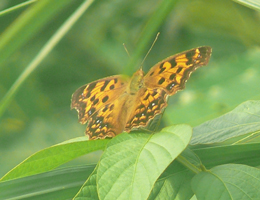
- Blue admiral
-
Family: Nymphalidae; Scientific name (Kaniska canace)
Larvae host plants: plants in the Liliaceae (lily) family (china root, etc.)
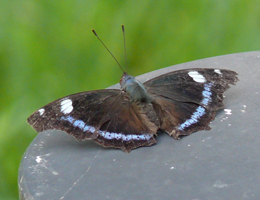
- Chinese bushbrown
-
Family: Nymphalidae; Scientific name: Lethe gotama
Larval host plants: plants in the Poaceae (grass) family (Pleioblastus chino, etc.)
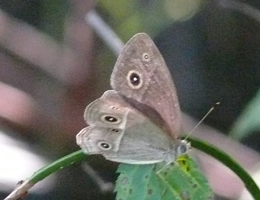
- Chinese windmill
-
Family: Papilionidae; Scientific name: Atrophaneura alcinous
Larvae host plants: Plants in Aristolochiaceae (birthwort) family
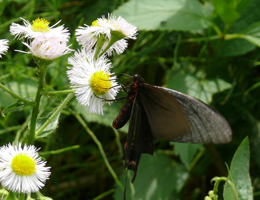
- Common five-ring
-
Family: Nymphalidae; Scientific name: Ypthima argus
Larval host plants: plants in the Poaceae (grass) family and Cyperaceae (sedge) family
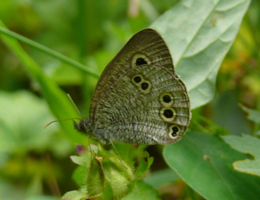
- Goschkevitschi's Labyrinth
-
Family: Nymphalidae; Scientific name: Neope goschkevitschii
Larvae host plants: plants in the Poaceae (grass) family (Simon bitter bamboo, etc.)
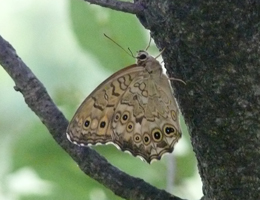
- Pallas' sailer
-
Family: Nymphalidae; Scientific name: Neptis Sappho
Larvae host trees: trees in the Ulmaceae (elm) family (Japanese elm, etc.)
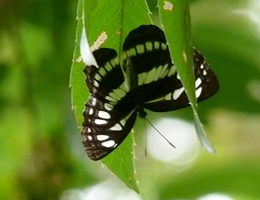
- Pale grass blue
-
Family: Lycaenidae; Scientific name: Pseudozizeeria maha
Larvae host plants: plants in the Oxalidaceae family
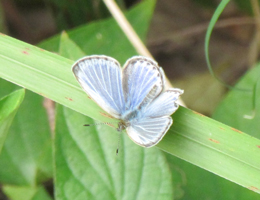
- White admiral
-
Family: Nymphalidae; Scientific name: Limenitis Camilla
Larval host plants: plants in the Caprifoliaceae (honeysuckle) family
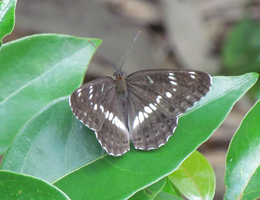
Reference: Katsuomi Matsumoto. Yamakei Pocket Guide No. 9 (Butterflies and moths). 1999
Elementary school children invited to a nature walk class
On July 10, 2017, we invited 27 second-grade children from Meiwa-higashi Elementary School of Meiwa, Gunma Prefecture, to a nature walk class at the Advantest Biotope. This was the seventh year we hosted this event. The children tried to catch red swamp crawfish to help eradicate this invasive alien species. Thanks to the successful measures we took to eradicate invasive alien species, they ended up with no catch as in the previous years. Then we moved to the grassy field to catch insects. The children were excited every time they caught a dragonfly or grasshopper. The insects they caught were brought back to the school and used in life environmental studies by observing them and taking photographs of them..
